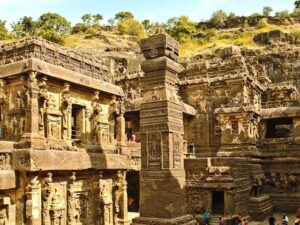
The Ellora caves, locally known as ‘Verul Leni’ are located on the Aurangabad-Chalisgaon road at a distance of 30 km north-northwest of Aurangabad, the district headquarters. The name Ellora itself inspires everyone as it represents one of the largest rock-hewn monastic-temple complexes in the entire world. Ellora is also world famous for the largest single monolithic excavation in the world, the great Kailasa (Cave 16).
The thirty-four caves of Ellora, cut side by side in the wall of a high basaltic cliff extending for more than two kilometers, constitute one of the most invaluable properties of the World Heritage.
This rupestral ensemble is not, like that of Ajanta, the expression of a single belief, rather it is the product of the three principal religions of ancient India. Progressing from south to north along the cliff, one discovers successively the twelve caves of the Buddhist group, which appear to be the oldest (between ca. 600 and 800) and comprise monasteries and a single large temple (cave 10); then the 26 caves of the Brahmanical group (ca. 600 to 900) which are no doubt the most well-known of Ellora with the “Cavern of the ten avatars” (cave 15) and especially the Kailasha Temple (cave 16), an enormous complex, most likely undertaken during the reign of Krishna I (757-783); and, finally, the Jain group (caves 30-34) whose sanctuaries were created by the sect of the Digarnbara towards ca. 800-1000. The Jain caves, the last to be excavated, drew their .inspiration from the art already existing at Ellora : cave 32 recalls by certain of its dispositions the Kailasha Temple.
Criterion (i): The ensemble of Ellora is a unique artistic achievement, a master piece of the creative genius of man. If one considers only the work of excavating the rock, a monument such as the Kailasha Temple is a technological exploit without equal. However, this temple, which transposes models from “constructed” architecture, offers as well an extraordinary repertory of sculpted and painted forms of a very high plastic quality and an encyclopaedic program.
Criterion (iii): Ellora brings to life again the civilization of ancient India with its uninterrupted sequence of monuments from AD 600 to 1000.
Criterion (vi): The Ellora Caves not only bear witness to three great religions : Buddhism, Brahmanism, and Jainism but they illustrate the spirit of tolerance, characteristic of ancient India, which permitted these three religions to establish their sanctuaries and their communities in a single place, which thus served to reinforce its universal value.
Source:
http://asi.nic.in/asi_monu_whs_ellora.asp
http://www.attractionworld.net/2016/04/ellora-caves-impressive-rock-cut.html
http://whc.unesco.org/en/list/243


